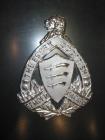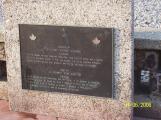1
The Essex Scottish cap badge1927-1954
Windsor, Ontario, Canada
 Credits:
Credits:Essex and Kent Scottish Windsor, Ontario
S. Michael Beale
The Windsor Star, John Coleman
2
The Essex Scotttish ancestry dates back to a militia unit founded in 1763. Militiamen from the Windsor area saw service in their own battalion in the War of 1812and the Upper Canada rebellion in 1837-38. In 1885 the Essex Battalion of Infantry, headquartered in Windsor is formed. In 1887 the name is changed to the 21st Battalion, Essex Fusiliers. In1900 some of its officers and men served in the Boer War.With the outbreak of First World War in 1914, Fusilier's commanding officer Col.E.S.wigle organizes the 18th Battalion of the Canadian Expeditionary Force. Later the 99th and 241st Batallions were also recruited through the Fusiliers. The three batallions won18 battle honors from 1914 until the war ended 1n 1918. In 1919 the battalions were disbanded and the Essex Fusiliers were reformed.In 1927 the regiment adopted the Highland dress and is renamed The Essex Scottish (Highlanders) under the command of Lt.-Col. Alan Prince, great grandson of Col. John Prince. The official tartan isthe McGregor, named for Lt.-Col. Walter McGregor, whose family founded Ford of Canada and who supplied the funds for the new uniforms.
The regimental crest has a red shield with three white sea axes- symbol of Essex County, England, the motto Semper Paratus (Always Ready) and a lion's head at the top. The Highland Laddie is the regimental quick march.
The Windsor Star Saturday, August 12, 2006.
3
Essex Scottish prisoners taken in Dieppe raid are marched for transport to POW camps19 August 1942
Red Beach, Dieppe, France
 Credits:
Credits:The Windsor Star
4
Those who were captured as prisoners of war were taken to a prisoner of war camp in Lamsdorf. There the men tied to maintain some semblance of "life". As one survivor, Company Sgt. Maj. Con Stapleton recalled,"at this camp and others like Stalag V111-B, there was a monotonous menu routine which consisted of soup, potatoes and bread. Sometimes bugs or a horse's eye would pop up in the soup. The men were never openly abused in the camps. But often their basic needs of adaquate food, heat and water were neglected".Credit: The Windsor Star- Wed. August 19,1992
